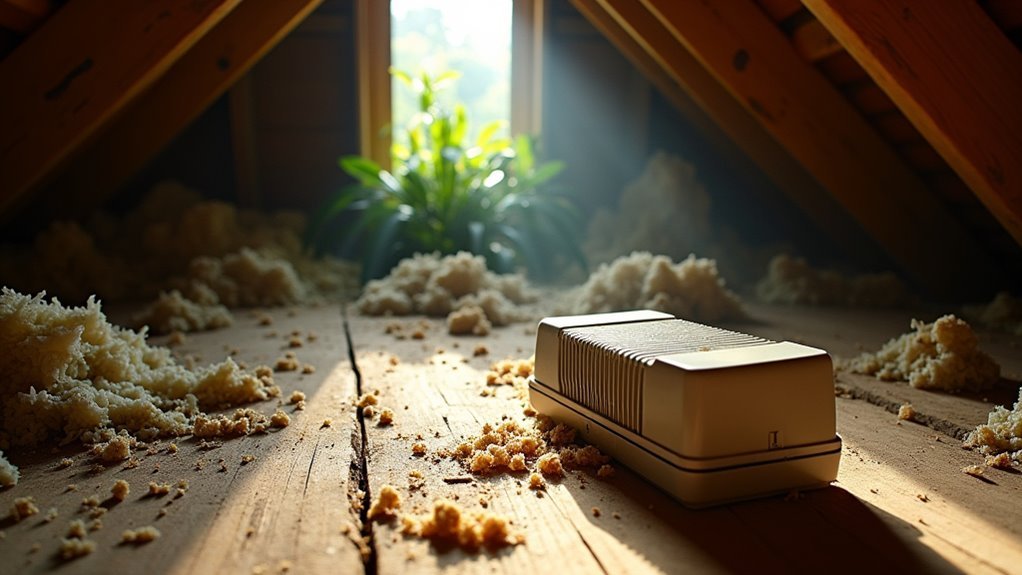To trap attic pests safely, you’ll first need to identify the specific animals through their droppings, sounds, and damage patterns. Use appropriate equipment like snap traps for rodents, live traps for squirrels and raccoons, and exclusion devices for bats. Always wear protective gear including gloves, masks, and safety goggles when working in your attic. Place traps along travel routes near droppings and check them daily. Follow local wildlife regulations for humane release, and discover thorough strategies that’ll keep your attic pest-free permanently.
Identifying Common Attic Pests and Their Warning Signs

Before you can effectively trap attic pests, you’ll need to identify exactly what’s invaded your space. Each pest leaves distinct signs that’ll help you determine your unwelcome guests.
Listen for scurrying noises and check for disturbed insulation – these typically indicate squirrels, who also leave nesting materials behind.
Disturbed insulation and scattered nesting materials in your attic are telltale signs of squirrel activity overhead.
Raccoons create louder disturbances, tear ducts, and leave larger droppings. If you hear nighttime squeaking and gnawing sounds, you’re likely dealing with rats or mice. Look for small pellet-shaped droppings from mice or larger ones from rats.
Bats produce faint scratching or rustling noises and leave guano that poses health risks.
Regular attic inspections help you spot entry points like loose soffits before infestations escalate.
Locating Entry Points and Travel Routes
You’ll need to thoroughly inspect your home’s exterior to identify where pests are entering your attic, focusing on loose siding, damaged vents, and gaps around pipes or utility lines.
Once you’ve spotted potential entry points, use cameras or motion sensors to track the animals’ movements and determine their preferred travel routes.
This information helps you understand when pests are most active and which pathways they use to access different areas of your attic.
Identifying Animal Entry Points
When dealing with attic pests, finding their entry points serves as your foundation for effective trapping and exclusion. Start by inspecting your attic thoroughly, searching for small openings, gaps, and cracks. Remember that animals can squeeze through holes as tiny as a quarter, so don’t overlook minor damage.
Look for telltale signs like disturbed insulation, droppings, and gnaw marks that reveal frequent travel routes and nesting areas. Focus your exterior inspection on loose siding, damaged soffits, and compromised vents that create easy access.
Check where tree branches contact your roof, as these natural bridges invite wildlife inside. Use a flashlight to examine dark corners and hidden crevices where bats and other nocturnal animals prefer hiding during daylight hours.
Mapping Pest Travel Paths
Where do these unwelcome visitors travel once they’ve invaded your attic space? Mapping pest travel paths requires careful observation of telltale signs that reveal their preferred routes.
Look for droppings, gnaw marks, and disturbed insulation along walls and corners—these indicate frequent travel areas. Dark smudge marks on surfaces show where rats and mice repeatedly brush against structures.
Monitor activity during dusk and dawn when nocturnal pests are most active. You’ll gain valuable insights into their movement patterns by watching these peak activity periods.
Document your findings by sketching their routes and noting concentration areas.
Regularly inspect for new signs of damage or activity to refine your understanding. This ongoing observation helps you adjust your approach and identify changes in their behavior patterns.
Choosing the Right Trapping Equipment for Different Animals

Since different attic pests require specific trapping approaches, selecting the right equipment becomes essential for successful and humane removal.
Choosing pest-specific trapping equipment ensures both effective removal and humane treatment of unwanted attic inhabitants.
For mice and rats, traditional snap traps work effectively when baited with peanut butter or cheese. Position these traps along their established travel routes for maximum success.
Squirrels need sturdier solutions like live traps or one-way exclusion doors that prevent re-entry. You’ll also want steel mesh to seal entry holes permanently.
Raccoons require large live traps or one-way doors, and you can encourage their departure by creating unwelcoming conditions with bright lights and noise.
For opossums, use humane traps baited with fruits or pet food near their travel paths.
Bats require specialized exclusion devices rather than traditional traps, since many species have federal protection requiring humane removal methods.
Strategic Trap Placement for Maximum Effectiveness
After selecting appropriate trapping equipment, your success depends heavily on where you position those traps within your attic space.
Strategic trap placement for maximum effectiveness requires understanding pest behavior patterns and activity indicators.
Position traps along these key locations:
- Travel routes – Place traps parallel to walls where rodents typically run, especially near visible droppings.
- Active nesting areas – Target zones where you’ve heard scurrying noises or noticed disturbed insulation.
- Stable surfaces – Guarantee trap placement on secure, non-wobbly surfaces that won’t deter cautious pests.
- Multiple bait stations – Use various effective lures like peanut butter or meat fat to attract different species.
Check traps regularly to maintain fresh bait and guarantee continued functionality for ideal capture rates.
Safe Baiting Techniques and Lure Selection

Proper trap placement sets the foundation for successful pest control, but selecting the right bait and applying it correctly determines whether those strategically positioned traps will actually capture anything.
Safe baiting techniques begin with choosing high-protein lures that rodents and squirrels find irresistible. Peanut butter, bacon fat, and sunflower seeds work exceptionally well because they appeal to these pests’ natural dietary preferences.
You’ll want to keep traps continuously baited rather than placing bait intermittently, as consistent availability prevents pests from becoming accustomed to sporadic food sources.
For juvenile rats, consider using mousetraps instead of traditional rat traps since their smaller size makes them more effective. Guarantee your traps remain stable and secure with heavy bases or ground anchoring to prevent wobbling that might deter cautious pests.
Humane Trapping Methods for Wildlife Removal
When you’re dealing with attic pests, selecting the right live trap makes all the difference in ensuring both your safety and the animal’s well-being.
You’ll want to choose traps like Havahart models that allow creatures to enter safely while preventing escape until you can relocate them.
Once you’ve captured an animal, your release practices should prioritize the creature’s health by checking traps frequently and transporting them to appropriate habitats far from your home.
Live Trap Selection
Because you’ll want to relocate attic pests without causing harm, live traps offer the most humane solution for wildlife removal.
These specialized devices, like those manufactured by Havahart, capture animals safely without injury, allowing you to relocate them away from your home.
When selecting the right live traps, consider these essential factors:
- Size appropriately – Choose 24x7x7 inch traps for squirrels, larger models for raccoons
- Use enticing bait – Peanut butter, fruits, or nuts greatly increase capture success
- Place strategically – Position along animal pathways, near droppings or nesting sites
- Check regularly – Monitor frequently to minimize animal stress and comply with local regulations
Proper trap selection guarantees effective, humane wildlife removal while meeting legal requirements for timely release.
Safe Release Practices
How do you guarantee captured wildlife gets a genuine second chance at freedom? Start by checking your catch-and-release traps frequently to minimize confinement stress and potential injury.
Once you’ve captured an animal, transport it at least 10 miles from your home to prevent return visits.
Scout the release location beforehand, confirming it’s suitable habitat free from predators and human disturbances. Don’t just dump the animal anywhere – choose an area where it can thrive.
Release during daylight hours when the animal can orient itself and find shelter.
Before setting any traps, research local wildlife regulations. Many areas require permits or have specific guidelines for trapping and relocating wildlife.
Following these laws guarantees you’re treating animals ethically while protecting yourself legally.
Monitoring Trap Activity and Maintenance Schedules
Once you’ve positioned your traps throughout the attic, you’ll need to establish a daily monitoring routine to maximize their effectiveness.
Monitoring trap activity requires consistent attention and systematic documentation to achieve ideal results.
Here’s your essential maintenance schedule:
- Check traps daily – Remove caught pests immediately to prevent odors and maintain trap functionality.
- Document everything – Keep detailed logs of trap locations, bait types, and activity patterns to identify pest behavior trends.
- Re-bait consistently – Replace bait every few days to guarantee traps remain attractive and effective.
- Inspect for tampering – Look for signs of movement or interference that indicate ongoing pest activity.
Clean traps thoroughly after each use, removing debris that could deter future captures and guaranteeing your equipment stays in ideal working condition.
Proper Handling and Disposal of Captured Pests
When you discover captured pests in your traps, proper handling becomes your top priority for maintaining both safety and effectiveness. Always wear gloves before touching any trap to protect yourself from bites, scratches, and potential diseases.
Use humane traps that enable easy, safe release of live animals far from residential areas, preventing their return. Check local wildlife regulations before release, as some species receive legal protection.
For disposal of captured pests that are deceased, seal them immediately in plastic bags before trash placement to control odors and health risks. After handling traps or animals, thoroughly wash your hands and clean any contacted surfaces to prevent contamination.
These proper handling protocols guarantee your safety while effectively managing attic pest problems.
Sealing Entry Points After Successful Removal
After safely removing pests from your attic, you must immediately focus on preventing their return by sealing every possible entry point. This critical step guarantees your pest control efforts remain effective long-term.
Follow these essential steps for thorough sealing entry points:
- Confirm complete evacuation – Verify all animals have exited before sealing to avoid trapping creatures inside.
- Use durable materials – Apply hardware cloth, sheet metal, or expanding foam to effectively close gaps.
- Inspect thoroughly – Check for openings as small as a quarter, since rodents can squeeze through tiny spaces.
- Repair structural damage – Fix damaged vents, soffits, and roof edges that provide wildlife access.
Maintain regular exterior inspections, especially after seasonal changes when animal activity increases, guaranteeing your sealing entry points efforts remain intact.
Preventing Re-infestation Through Environmental Controls
While sealing entry points provides immediate protection, controlling your property’s environment creates a hostile landscape that discourages pests from targeting your home in the first place.
Effective pest control starts with eliminating food sources by storing items in rigid plastic containers and keeping pet food sealed. Remove fallen fruit and dense vegetation near your home’s foundation, as these attract foraging animals.
Eliminate food sources by securing storage containers and removing fallen fruit to deter foraging animals from your property.
Prune trees and shrubs that touch your house to eliminate climbing routes for squirrels and rats. Install gutter guards to prevent debris accumulation that creates nesting opportunities and roof access points.
Regularly inspect your home’s exterior for gaps in roofing, vents, or siding, repairing damage immediately. Maintain a clean perimeter by removing debris that provides shelter and breeding sites for unwanted pests.
Safety Precautions for Working in Attic Spaces
Before you enter your attic to set traps, you’ll need proper protective equipment to safeguard against dust, allergens, and potential diseases from pest droppings.
You should also thoroughly inspect all entry points while wearing appropriate gear to identify where pests are gaining access to your home.
If you’re planning to use chemical baits or repellents, you must follow strict handling protocols to prevent accidental poisoning or respiratory issues in confined spaces.
Protective Equipment Requirements
Five essential pieces of protective equipment will keep you safe while trapping attic pests. Meeting protective equipment requirements isn’t optional when dealing with animals in your attic – it’s vital for preventing injuries and health risks.
Your safety gear should include:
- Well-fitted mask – Protects against dust, allergens, and potential pathogens present in attic environments.
- Durable gloves – Prevents bites or scratches when handling traps or inspecting for pests.
- Safety goggles – Shields your eyes from debris, droppings, or insects disturbed during inspections.
- Hard hat – Provides protection against head injuries from low beams or falling objects.
Don’t forget proper footwear with non-slip soles.
You’ll maintain stability on potentially uneven or cluttered surfaces while steering through tight attic spaces during pest control activities.
Entry Point Inspection
Once you’ve donned your protective equipment, you’ll need to conduct a thorough entry point inspection to identify how pests are accessing your attic.
Use your flashlight to examine every corner of the attic crawlspace, paying special attention to shadows and areas behind insulation where entry points often hide. Look for gaps around vents, pipes, and electrical wiring where small animals can squeeze through.
Check for disturbed insulation or scattered droppings, which indicate active nests nearby. Inspect the roofline for damaged shingles or loose boards that create openings.
Don’t forget to examine the junction where walls meet the roof, as these areas frequently develop cracks. Document each potential entry point you discover for effective trap placement later.
Chemical Handling Protocols
When dealing with chemical pest control products in confined attic spaces, you’ll face unique safety challenges that require strict protocols to protect your health.
Proper chemical handling protocols become even more critical when targeting rats and other pests in these poorly ventilated areas.
Follow these essential safety measures:
- Wear complete PPE including gloves, masks, and goggles to prevent chemical exposure and inhalation of toxic fumes.
- Maximize ventilation by opening all available windows and doors before applying any pest control chemicals.
- Read manufacturer instructions thoroughly, following exact dosage and application methods for safe use.
- Store chemicals securely away from children and pets, then dispose of containers according to local environmental regulations.
When to Call Professional Pest Control Services
While DIY trapping methods can handle many attic pest situations, certain circumstances require professional intervention to guarantee both safety and effectiveness.
If you’re hearing persistent scurrying noises or finding droppings despite your DIY efforts, it’s time to contact professional pest control services. These experts can identify and seal entry points you might miss, preventing future infestations.
You’ll definitely need professionals if you suspect federally protected species like bats are present, as DIY removal could result in legal trouble.
Health risks from rodent droppings that transmit diseases also warrant expert intervention for safe cleanup. Additionally, if your traps aren’t working or you’re uncomfortable handling live animals, professionals provide humane removal and customized solutions for your specific situation.
Long-term Attic Protection and Monitoring Strategies
After addressing immediate pest problems, establishing a thorough monitoring system becomes your most effective defense against future attic invasions.
Long-term attic protection requires consistent vigilance and proactive measures to maintain a pest-free environment.
Essential monitoring strategies include:
- Regular inspections – Check monthly for droppings, gnaw marks, and other pest signs to catch problems early.
- Seal entry points – Use hardware cloth or expanding foam to block potential access routes permanently.
- Install monitoring equipment – Deploy motion-activated cameras or traps to detect new activity immediately.
- Maintain cleanliness – Keep your attic clutter-free and remove potential nesting materials.
Schedule professional inspections annually to guarantee your long-term attic protection strategy remains effective and adapts to changing wildlife patterns.
Frequently Asked Questions
How Do You Trap Critters in the Attic?
You’ll place snap traps or live traps along walls near droppings, baiting them with peanut butter or cheese. Check traps frequently, dispose of captured animals humanely, and seal entry points afterward.
How Do You Get Rid of Pests in the Attic?
Identify the pest species first, then use appropriate humane traps along their travel routes. Seal all entry points after removal using steel mesh or foam, and consider professional help for protected species.
How Do I Force Rodents Out of My Attic?
You can force rodents out by opening doors and windows for exit routes, installing bright lights and noise-makers to make the space uncomfortable, then using one-way exclusion doors that let them leave but can’t return.
What to Do if You Hear Critters in Your Attic?
First, keep kids and pets away from the area for safety. Open doors and windows so animals can escape naturally. Listen carefully to identify the type of critter, then contact professional pest control if needed.
In Summary
You’ll successfully eliminate attic pests by identifying them correctly, using proper trapping techniques, and sealing entry points. Remember, safety’s your top priority—wear protective gear and don’t hesitate to call professionals for dangerous situations. Once you’ve removed the pests, focus on prevention through regular monitoring and environmental controls. With consistent effort and the right approach, you’ll maintain a pest-free attic and protect your home from future invasions.





Leave a Reply